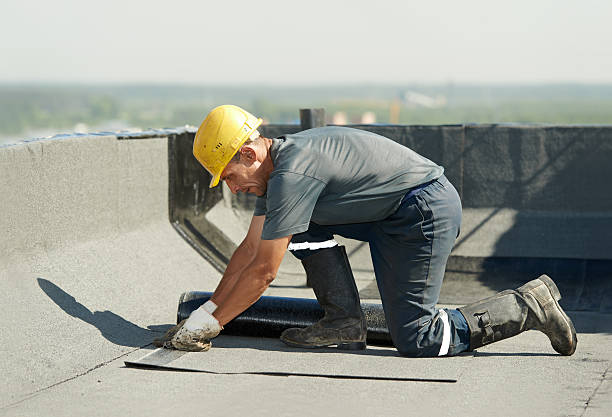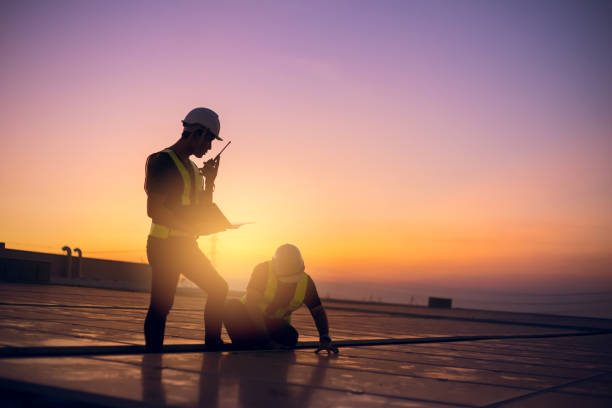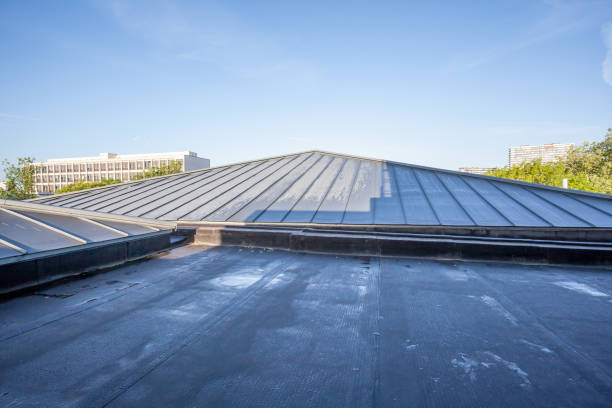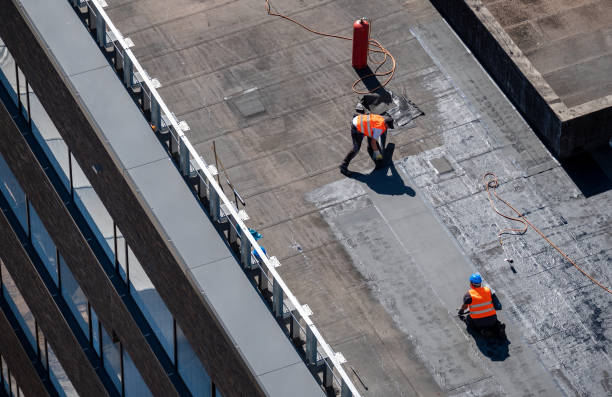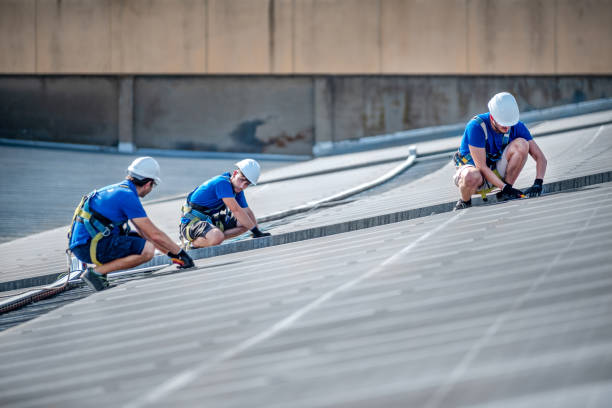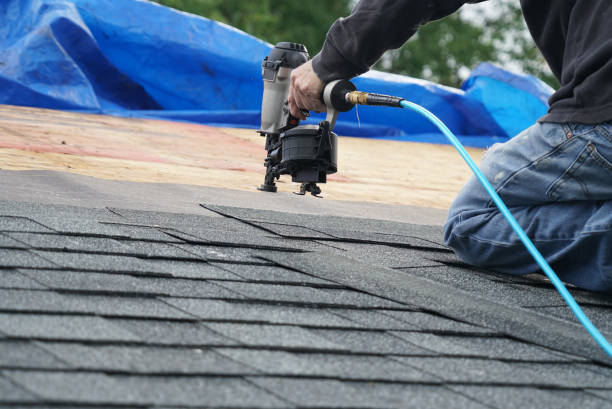Comprehensive Guide to Commercial Roofing in Phoenix, AZ: Understanding the Replacement Process

Replacing a commercial roof is a significant investment that requires careful planning and coordination. By understanding the process, business owners can minimize disruptions and ensure their new roofing system meets their long-term needs. Below is a detailed breakdown of the key stages involved in a commercial roof replacement project.
Initial Consultation and Assessment with a Commercial Roofing Contractor in Phoenix, AZ
The first step in the process is scheduling an initial consultation with a qualified commercial roofing contractor. During this phase:
– The contractor will inspect your existing roof to assess its condition. – Measurements and structural details are collected for accuracy. – Any specific concerns, such as drainage issues or visible damage, will be documented.
This phase helps determine whether repair or complete replacement is necessary.
Comprehensive Industrial Roofing Phoenix, AZ Inspections
A comprehensive inspection follows the initial consultation. This process typically includes:
– Core Sampling: A small section of the roof is removed to analyze its layers and identify moisture or material deterioration. – Thermal Imaging: Advanced tools may be used to detect heat loss or areas of trapped moisture beneath the surface. – Structural Analysis: The contractor evaluates whether your building can support a new roofing system, especially if heavier materials like metal are being considered.
This step ensures all underlying problems are identified before moving forward.
Planning and Material Selection for Commercial Flat Roofing Phoenix, AZ
Based on inspection results, you’ll work with your contractor to select materials that align with your budget, energy efficiency goals, durability requirements, and building design. Common material options include:
| Material Type | Benefits | Durability (Years) |
|——————|———————————|———————|
| EPDM Rubber | Cost-effective & weather-resistant | 20–30 |
| TPO (Thermoplastic Olefin) | Energy-efficient & heat reflective | 15–20 |
| Metal Roofing | Long-lasting & low maintenance | 40+ |
The planning stage also involves creating a schedule that minimizes disruption to your business operations.
Permit Acquisition for Commercial Roof Installation in Phoenix, AZ
Before work begins, contractors will handle permitting requirements based on local regulations. Proper permits ensure compliance with building codes and guarantee safety standards are met during construction.
5. Removal of Old Roofing System
The old roofing materials are systematically removed to prepare for installation: – Debris is carefully disposed of to avoid environmental hazards. – Specialized equipment prevents damage to surrounding structures during removal.
Some projects may involve partial roof replacement if only certain sections require attention.
6. Installation of New Roofing System
Once the deck is inspected and prepared: 1. Insulation boards (if required) are installed for energy efficiency. 2. The selected roofing material is applied according to manufacturer guidelines. 3. Additional elements like flashing, gutters, or drainage systems are installed for optimal performance.
During this phase, contractors focus on precision installation techniques that enhance durability while minimizing disruption to daily operations.
7. Final Inspection and Approval
Once installation is complete: – A thorough inspection ensures quality craftsmanship. – Contractors test key components like drainage systems for functionality. – You’ll receive documentation outlining warranty coverage and maintenance recommendations.
By following these steps closely, businesses can benefit from a smooth commercial roof replacement process while ensuring their property’s long-term protection against weather elements.
Key Factors That Determine the Cost for a Commercial Roofing Company in Phoenix, AZ
Understanding the cost of a commercial roof replacement is essential for budgeting and planning. Several factors influence the overall price, and being aware of these can help you make informed decisions. Below, we outline key factors that determine the cost of replacing a commercial roof.
1. Roof Size and Complexity
The size of your commercial roof is one of the primary factors impacting cost. Larger roofs require more materials, labor, and time, which increases expenses. Additionally, complex roof designs with unique shapes or features (e.g., skylights or vents) often require specialized labor and materials, which can add to the overall cost.
- Flat roofs: Typically less expensive due to ease of installation.
- Sloped roofs: May involve additional safety equipment and more intricate labor.
- Roof features: Elements like HVAC units or drains may increase complexity.
2. Roofing Material Selection
| Material | Average Cost per Square Foot | Life Expectancy | Maintenance Level |
| TPO (Thermoplastic Polyolefin) | $5–$8 | 20–30 years | Low |
| EPDM (Ethylene Propylene Diene Monomer) | $4–$7 | 15–25 years | Moderate |
| Metal Roofing | $7–$12 | 40–50 years | Low |
| Modified Bitumen | $4–$8 | 15–20 years | Moderate |
| Built-Up Roofing (BUR) | $5–$10 | 20–30 years | High |
When selecting materials, consider not only upfront costs but also long-term performance and maintenance needs.
3. Existing Roof Condition
Before a new roof can be installed, contractors must inspect the condition of your current roofing system. If significant damage is present—such as water intrusion or structural issues—repairs or removal may be necessary before replacement begins.
- Tear-off vs. overlay: A tear-off involves removing all old roofing layers; this is typically more expensive than an overlay where a new system is installed on top of the old one.
- Structural repairs: Damage to decking or insulation beneath the roof adds to project costs.
4. Labor Costs
Labor expenses vary depending on location, contractor expertise, and project complexity. Skilled labor for intricate installations or challenging designs will generally command higher wages.
Factors affecting labor costs include: – Regional differences in wage rates. – Project timeline—expedited projects may come at a premium. – Safety requirements for high-rise buildings.
5. Permits and Compliance
Most commercial roof replacements require permits to ensure compliance with local building codes and regulations. Permit fees vary by region but are essential to factor into your budget. Additionally: – Compliance with energy-efficiency standards (e.g., cool roofing regulations) might necessitate specific materials or enhancements. – Buildings in hurricane-prone areas may require wind-resistant systems that increase installation expenses.
6. Accessibility
The ease or difficulty of accessing your building’s roof can also influence costs: – Multi-story buildings: These may need cranes or lifts to transport materials safely. – Limited access points: Can slow down installation time, increasing labor costs.
Tips for Managing Costs Effectively
To optimize value while managing expenses: 1. Obtain multiple quotes from reputable contractors for comparison purposes. 2. Plan ahead—allowing sufficient time to evaluate options can help avoid costly rush jobs. 3. Consider long-term savings by investing in energy-efficient materials that reduce utility bills over time.
By understanding these factors, you’ll be better prepared to estimate costs accurately and make decisions tailored to your business’s needs while staying within budget constraints.
What Happens During a Comprehensive Commercial Roof Inspection and Assessment
A comprehensive commercial roof inspection and assessment is a critical first step in ensuring the longevity, safety, and functionality of your roofing system. This process involves a thorough evaluation of the roof’s condition, identifying any potential or current issues that could compromise its structural integrity or performance. Below is a detailed look at what typically takes place during this essential procedure.
Components of a Comprehensive Roof Inspection
- A roofing professional will perform a detailed visual examination of the roof, checking for visible signs of damage such as:
- Cracks
- Tears in membranes
- Ponding water
- Loose or missing flashing
- The inspector will also assess for any debris buildup, which can hinder proper drainage.
- Inspectors evaluate the structural components of the roof to ensure it can support its weight load, including equipment such as HVAC units.
- They may look for sagging areas or signs of water infiltration that could indicate weakened decking.
- Proper drainage is crucial to prevent water damage and pooling.
- Gutters and downspouts are inspected for blockages, corrosion, or other issues that may impede water flow.
- The condition of roofing materials (e.g., single-ply membranes, metal panels) is closely examined for wear and tear.
- This includes checking seams, fasteners, and coatings to determine if repairs or replacements are necessary.
- Inspectors often check ceilings and walls inside the building for signs of leaks or water damage.
- Mold growth or discoloration can be indicators of underlying roofing problems.
Advanced Tools and Techniques
In addition to traditional visual inspections, modern technologies are often utilized to provide deeper insights into the roof’s condition: – Infrared Scanning
Used to detect moisture trapped beneath roofing membranes without tearing into materials. – Core Sampling
A sample from the roof structure may be taken to analyze material composition and degradation over time. – Drone Inspections
Ideal for large commercial properties, drones provide high-definition visuals from all angles without requiring manual climbing.
Deliverables After an Inspection
Upon completing the inspection, a detailed report is typically provided by your roofing contractor. This report will include:
– Photographs documenting observed issues
– A list of recommended repairs or replacements
– An estimate for maintenance costs
– Insights on remaining lifespan based on current conditions
| Key Area | Potential Issues Assessed | Recommended Solutions |
| Roofing Membranes | Tears, punctures, UV degradation | Repairs/Re-coating |
| Flashing & Seals | Loosened edges, corrosion | Replacement/re-sealing |
| Drainage Systems | Clogs in gutters/downspouts | Cleaning/repairs |
| Structural Decking | Water damage weakening supports | Reinforcement/replacement |
Benefits of Regular Roof Inspections
Regular inspections not only help mitigate potential damage but also extend the lifespan of your commercial roofing system. Some notable benefits include:
– Early identification of minor issues before they escalate into costly repairs
– Increased energy efficiency by addressing insulation gaps or leaks
– Assurance that your building remains compliant with safety regulations
By understanding what happens during a comprehensive commercial roof inspection and assessment, businesses can make informed decisions about maintaining their assets while optimizing long-term costs.
Exploring Material Options for Your Commercial Roofing Project
When it comes to selecting the right materials for your commercial roofing project, making an informed decision is crucial. The materials you choose will impact the roof’s durability, energy efficiency, maintenance requirements, and overall cost. Below is a detailed guide to help you explore and evaluate various material options for your commercial roof.
Common Commercial Roofing Materials
- Benefits:
- Highly energy-efficient due to its reflective surface.
- Resistant to UV radiation, chemical exposure, and fire.
- Lightweight yet durable with a lifespan of 15–20 years.
- Susceptible to punctures in areas with heavy foot traffic unless reinforced.
- Benefits:
- Excellent durability and flexibility across various weather conditions.
- Easy installation in large sheets, reducing seams that can lead to leaks.
- Lifespan ranges from 20–30 years with proper maintenance.
- Black color absorbs heat unless coated with a reflective layer.
- Benefits:
- Extremely long lifespan of 40–70 years depending on the type of metal used (e.g., steel, aluminum).
- Superior resistance to fire and high wind speeds.
- Can be coated with reflective paint for enhanced energy efficiency.
- Higher upfront costs compared to other materials.
- Potential for noise during rain or hailstorms without proper insulation.
- Benefits: Provides strong waterproofing capabilities due to its asphalt base. Suitable for roofs with low slopes or flat designs
Factors That Affect Material Choices
- Climate Conditions For properties located in harsh climates—whether extreme heat or cold—materials like TEO
How to Prepare Your Business for a Smooth Commercial Roof Replacement
Proper preparation is essential to ensure that your commercial roof replacement project is completed efficiently and with minimal disruption to your business operations. Below, you’ll find key steps and strategies to help you prepare your business for a smooth roofing project.
Communicate with Stakeholders
- Employees: Inform them of the timeline, potential noise levels, and restricted areas during construction.
- Tenants (if applicable): Provide details of the work schedule and any expected disruptions that might affect their operations.
- Customers: If necessary, place signs or send notifications alerting customers about possible changes in accessibility or parking facilities during the project.
Coordinate with the Roofing Contractor
- Scheduling: Determine start dates, estimated completion timelines, and daily working hours.
- Access Requirements: Provide information about roof access points and ensure they align with contractor needs.
- Safety Protocols: Clarify safety measures that will be in place for workers and occupants of the building.
Protect Business Assets
- Cover or move expensive machinery under work zones.
- Relocate valuable items such as inventory or office furniture away from areas prone to leaks or debris.
- Protect IT systems by assessing whether vibrations might disrupt servers or other critical infrastructure.
Plan for Limited Access Areas
Certain parts of your building may need restricted access during construction for safety reasons. Work with your contractor to identify these zones and establish alternative routes if necessary.
| Area Type | Potential Disruption | Suggested Action |
| Parking Lots | Blocked spaces due to equipment | Designate alternative spots |
| Entrances/Exits | Temporary closures | Set up alternate entry points |
| Workspaces Beneath Roof | Noise and falling debris | Plan remote work if possible |
Adjust Business Operations
- Implement remote work policies if noise or limited space could hinder productivity.
- Reschedule non-essential meetings or events during peak construction hours.
- Alert suppliers about potential delays in receiving deliveries at standard drop-off points.
Ensure Compliance with Local Regulations
Before starting the roof replacement process, ensure all permits are secured by either you or your contractor as required by local government authorities.
Monitor Progress Closely
Stay engaged throughout the project by conducting regular check-ins with your contractor to address any unexpected issues early on.
By taking these preparatory steps, you can minimize disruptions while keeping employees safe and maintaining business continuity during a commercial roof replacement project.
Understanding the Types of Warranties Available for Commercial Roofs
When investing in a commercial roof, understanding the warranties available is crucial. A warranty not only provides financial security but also ensures peace of mind by safeguarding your investment against unexpected defects or issues. Below is an overview of the common types of warranties offered for commercial roofing systems, their features, and what to consider when evaluating them.
Types of Commercial Roof Warranties
- Covers: Defects in roofing materials caused during the manufacturing process.
- Duration: Often ranges from 10 to 30 years, depending on the material and manufacturer.
- Limitations: Does not typically cover installation errors or poor workmanship.
- Covers: Issues arising from improper installation or craftsmanship errors by the contractor.
- Duration: Commonly lasts 1 to 5 years but can vary significantly based on the contractor’s policy.
- Limitations: Workmanship warranties generally do not cover material defects; they are strictly related to installation quality.
- Covers: Both material defects and installation workmanship issues, providing comprehensive protection.
- Duration: Typically lasts between 10 and 20 years, depending on specific terms set by manufacturers and contractors.
- Limitations: May have exclusions such as natural disasters or damage due to poorly maintained roof systems.
- Covers: The cost of labor and materials needed for repairs with no monetary cap, provided repairs meet warranty guidelines.
- Duration: Generally aligned with full-system warranties but offers added financial protection.
- Limitations: Does not account for damage caused by neglect or unauthorized repairs.
- Covers: Additional assurance through routine inspections conducted under a maintenance agreement.
- Benefits include early detection of potential problems that could void other warranties.
Key Considerations When Selecting a Roofing Warranty
- Duration: Assess how long you plan to occupy the building—longer-term warranties may be more advantageous for owned properties compared to leased spaces.
- Coverage Scope: Ensure you fully understand what is included in terms of both materials and workmanship, as well as any exclusions or limitations.
- Transferability: Determine if the warranty can be transferred to a new owner in case you decide to sell your property.
- Inspection Requirements: Many manufacturers require regular inspections and maintenance as part of their warranty conditions; failure to comply may void coverage.
- Cost Vs Value: While more extensive warranties come at a higher price, their value lies in providing greater security against costly repairs down the road.
Warranty Comparison Table
| Type | Coverage | Typical Length | Key Limitation | Best For |
| Manufacturer’s Material | Defects in materials | 10–30 years | Excludes workmanship errors | New builds with trusted contractors |
| Contractor Workmanship | Installation issues | 1–5 years | Excludes manufacturing flaws | Companies prioritizing installer accountability |
| Full-System | Materials + Installation | 10–20 years | May exclude natural disasters | Businesses seeking complete peace of mind |
| No-Dollar-Limit (NDL) | Unlimited repair costs | Matches full-system duration | Neglect-related damages | High-value projects needing maximum protection |
Tips for Maximizing Your Warranty Benefits
- Always hire certified installers approved by material manufacturers; unauthorized contractors may nullify certain warranties.
- Retain thorough records of all roof inspections, maintenance logs, and repair activities.
- Familiarize yourself with warranty claim procedures ahead of time to streamline responses in case an issue arises.
Understanding these various aspects ensures your commercial roofing investment will remain protected over time while offering optimum value for your business operations.
- Step-by-Step Guide to Commercial Roofing Phoenix, AZ Installation
- Comprehensive Guide to Commercial Roofing in Phoenix, AZ: Understanding the Replacement Process
- How to Ensure a Smooth and Efficient Commercial Roofing Phoenix, AZ Installation Process
- Tips for Selecting a Commercial Roofing Company Phoenix, AZ for Long-Lasting Roof Solutions
- Selecting the Best Materials for Commercial Roof Installation Phoenix, AZ to Maximize Durability and Longevity
- A Complete Guide to Industrial Roofing Phoenix, AZ: Top 16 Materials, Costs, Pros, and Cons
- Initial Assessment and Consultation with a Commercial Roofing Company Phoenix, AZ
- Key Factors to Consider for a Successful Project with a Commercial Roofing Company Phoenix, AZ

